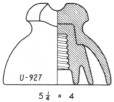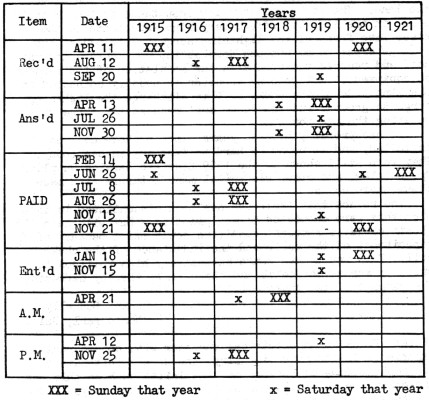Porcelain Insulator News
by Jack H. Tod, NIA #13
Reprinted from "INSULATORS - Crown Jewels of the Wire", January 1980, page 31
Dear Jack:
I have been intending to drop you a line
since your request for Pittsburg "date control" markings first
appeared in your column last July.
I picked up two mahogany brown Pittsburg
U-933 glazewelds in Maine last summer. One is unmarked, but the other one has a
date stamp "JUL 8 PAID" just below the unglazed top firing rest.
Also,
Jack, you might let me know what the approximate value of these might be.
Len
McGowan
Webster, N.Y.
- - - - - - - - -
Dear Len:
Many thanks for the report of this date stamp.
It seems like a long road, but hopefully someday we'll get enough of these
"date control" markings reported by collectors to crack Pittsburg's
dating code by the method suggested last year by Matt Grayson.
On these old
insulators, it's not so much a problem in determining exact "value" as
with locating someone who wants or needs the item for his collection. I've found
that it doesn't help to put a $1 sticker on a $5 insulator at a show if no one
happens by who wants the item, but the insulator would quickly sell even at a
premium over the $5 to anyone who really wants it for his collection. If forced
to punt on these specimens, I'd put a sticker of $4 to $5 on the unmarked one
and maybe double that on the dated one. These aren't old classics, but
nevertheless are nice glazewelds.
Jack

Dear Jack:
Last week I picked up
an interesting item at an Arts and Craft show in Anaheim. It is a white Imperial
similar U-927 (but 5-1/8" x 3-11/16" and with innermost petticoat
recessed upward about 3/16").
I have two of the larger Imperials such as
this shape but never knew these smaller versions existed. There is a small
defect above the trade mark where the glaze didn't cover a rough spot, but it is
in good condition otherwise.
It has three markings -- the crown trade mark, the
wordy "Manufactured by..." stamp, and a date 6-17-01. This trade mark
isn't quite like the one shown in your book, since it has some extra elements
above the band that look like the clubs on playing cards.
It cost all of $1.50,
so bargains are still around if you look. The owner would not sell a blue THOMAS
U-282A hat for $2.00 when I dickered below the $3 sticker. He said he'd keep it
and put it in his collection(??).
Errol Q. Bond
Fullerton, Calif.
- - - - - - - - -
Dear Errol:
That's a nice Imperial, and the Sim U-927 would be close enough. There are
numerous minor variations in all these oldies, both the glazeweld and one-piecer
versions.

The Imperial trademark in the book isn't quite complete, since I
didn't have a specimen with a nice clear marking when I made the drawing. The
extra couple wiggles inside the crown appear to be fleur-de-lis, but until you
mentioned it, I never thought to note on many specimens since 1971 the exact
character of these elements -- and still can't see them clearly on any specimen
I have now. Maybe a reader can help us out if he has a specimen with a very
clear marking, a magnifying glass and some artistic ability.
Incidentally, I
never came across this trademark in the registrations, but then I guess anyone
can state it as a "trade mark" without registering it at the Patent
Office. Yes, how sweet it is! You can come unto some real bargains when sellers
don't take the trouble to first check in a book or with some acquaintance
willing to help in pricing before parting with items, and this is even true at
insulator show tables!
At a flea market I once saw an ordinary porcelain beehive
with a $3 sticker on it. Next to it sat another insulator with a $1.50 sticker
on it, and he said he'd take a buck for it. So I paid him the buck and walked
away with my THOMAS transposition -- and a little smile on my face.
Jack
Last summer Matt Grayson (Roslyn, NY) suggested an idea that we might crack the
date code used by Pittsburg High Voltage Insulator Co. in the 1915-1921 period
if we recorded enough of the "date control" markings on specimens and
then consulted the calendars for those years. The assumption would be that the
work dates were probably not Sundays, and also maybe not even Saturdays. The
table below is an update of our project on this showing all date stamp markings
which have been reported thus far.
I've seen many of these dated Pittsburg
specimens in collections and on show sell tables in past years, but we simply
can't have hope for success in this project unless each reader will take the
time to send us a postcard reporting the date control stampings on specimens
they have!

Large Image (119 Kb)
Dear Jack:
In response to your request for help
with an answer, here is some information on Frank Shore's interesting item as
pictured on page 24 of the October 1979 issue of CJ. T
he device is correctly
called a choke coil. The picture is upside down because the insulator petticoats
are turned up; this choke coil assembly would be mounted underhung. Some are
upright as shown, but the insulators are reversed with their petticoats
downward. These are connected in the circuit as shown. in my sketch (copied
below).

When lightning strikes an overhead line, a very steep wave front travels
along the line and causes insulation failure in equipment such as transformers
or motors connected to the line. The choke coil has low inductance to the 60
cycle power in the line but offers very high inductance to the steep wave front
of the lightning surge. This causes the voltage crest to be chopped down as the
wave enters the choke coil and reduces the stress on the insulation of the
connected equipment. A lightning arrestor is usually connected on the line side
of the choke coil to discharge the lightning surge to ground, and the choke coil
reduces the surge voltage entering the station bus.
It has probably been 50
years since a choke coil has been installed, and it would be hard to find any in
use today. They were still shown in the 1929 Electric Service Supplies Co.
catalog, and other electrical manufacturers also made these choke coils.
The
reason that their use has been discontinued is that when they were connected to
equipment or a bus with metallic sheath cable, a resonant condition could exist
because of the capacitance of the cable and the inductance of the choke coil.
This would then cause excessively high voltages to build up across the cable and
choke coil, thereby defeating the purpose of the choke coil.
Frank Donnelly
Menlo Parl, Calif.
- - - - - - - - -
(Note: Frank is an electrical engineer with considerable
experience in the power industry, and we are fortunate that he keeps feeding us
answers on "whatisits" such as this one and others we've had in the
past. Many thanks to you Frank for this and other answers to our queries.
Jack)

Dear Jack:
We have been out looking for goodies for our collection, but
they're a little scarce, and we haven't come up with much. At one flea market,
we did get a cleat for our collection, and the name "EXEMPLAR" is a
new one for us. This is a standard 3-wire cleat, and the marking on it is
recess-embossed as shown in the sketch.
Emma & Tony Almeida NIA #979 and
#1166
Shrewsbury, Mass.
- - - - - - - - -
Dear Emma & Tony:
This tradename has me stumped as
to manufacturer. It's also unusual in that most cleats just bore the
manufacturer: name or initials. It's usually on nail knobs that you find all the
fancy "presto" tradenames such as this.
Jack
Dear Jack:
... Also,
although it may be quite common, I'll pass along to you some information on a
group of U-244 "MACOMB" insulators I have just looked at. All are very
crude, and there's one each of the following glazes: black, tan, white and blue.
Tom Kasner
Casper, Wyoming
- - - - - - - - -
Dear Tom:
... I'm curious as to the MACOMB U-244's
you mention. My first impression is that someone has been fiddling around with
his little kiln out in his patio. And if that's the case, he merely turned a
bunch of nice $5 insulators into a pile of junk. All the known Macomb pin types
made by Illinois Electric Porcelain are well made dry press insulators with
various shades of brown glaze. Surely you can tell by looking at them if they've
been diddled with.
If these "things" are somewhat undersized, or if
the threads are not neat and perfect, he didn't ruin any original insulators but
nevertheless spent a lot of effort creating some novelty items good only for
door stops.
Jack
| 